#tallships – Rugged sailing in romantic tall ships; the camaraderie of the sea; character development. It's an inspiring combination which has gripped maritime nations for more than a century as sail has given way to more utilitarian sources of power. First there was steam. Then steam in turn was superseded by diesel and even nuclear power. And with each stage, there has been a remorseless drive towards reducing manning levels.
So what on earth is there now to occupy people who, in a former era, might have found a meaningful role in life as crew on board a sailing ship? For with each new development in shipping, we realise ever more clearly that large sailing ships were one of the most labour-intensive objects ever created.
However, we don't need to look to the sea to find areas of human activity where technological development has made human input redundant, and large sectors of the population largely purposeless. It's the general social malaise of our time. So for many years, the majority of maritime countries have found some sort of solution by an artificial return to the labour-intensive demands of sailing ships.
But in an increasingly complex world with ever more sources of distraction and entertainment, does the established model of sail training still work as well as it once did? W M Nixon meets a man who thinks we need a new vision for best using the sea and sailing ships to meet the needs of modern society's complex demands.
Tall Ships and Sail Training........They're evocative terms for most of us. Yet the buzzwords of one generation can surprisingly quickly become the uncool cliches of the next. That said, "Tall Ships" has stood the test of time. It's arguably sacred, with a special inviolable place in the maritime psyche.
So when we see a plump little motor-sailer bustling past with some scraps of cloth set to present an image of harnessing the wind's timeless power, we may be moved to an ironic quoting of Robert Bridges: "Whither, O splendid ship......" But somehow, citing Masefield's "a tall ship and a star to steer her by" would seem to be beyond the bounds of even the worst possible taste.
There's a simple purity about "Tall Ships". It works at every level. Google it, and you'll find the academics claim that it became official with its use by John Masefield in 1902 and Joseph Conrad in 1903, though Henry David Thoreau used it much earlier in 1849. But Conrad being the benchmark of most things maritime in academia, 1903 seems to be set in stone.

We all know what is meant by a true Tall Ship, but as these rig profiles indicate, the proliferation of sail training programmes has led to an all-inclusive approach
Yet at the vernacular level, it has been there much longer than any of them. There's a bit of maritime meteorological lore which our academics would probably dismiss as vulgar doggerel, but I've found it still moves me. When far at sea, with the underlying swell increasingly in evidence and the weather conditions which it describes clearly developing overhead, inevitably you'd remember this little couplet:
"Mackerel sky and mare's tails,
Make Tall Ships carry low sails".
It's not Yeats. But when you're on a formerly blue sea now turning grey and far from anywhere in a 25-footer, it's a little thought which can still make the hairs stand up on the back of your neck. And it's that mention of "Tall Ships" which gives it the added resonance. So things stand well with the phrase "Tall Ships". But what's the word on the continuing viability of "Sail Training"?
"I'm fed up with the constant use of the term "Sail Training". It's bandied about so much it has become meaningless. And always talking about "Sail Training" limits the scope of what we're trying to do. If we could find some useful phrase to replace "Sail Training", but something which is also more visionary than the very pedestrian "Youth Development" which is sometimes replacing it, then maybe we could go a long way to capture the imagination both of our potential supporters, and of the young people we hope will want to come aboard the ship".
The speaker is Neil O'Hagan, busy Executive Director of the Atlantic Youth Trust, which is actively developing ways and means of building a 40 metre sailing ship which will serve all Ireland in a wide variety of functions. And as he has immersed himself in this challenging project when he is clearly a very able person who could name his price in many roles in high-paying large corporations, it behoves us to pay attention.
We have been skirting the AYT and its project several times here recently. But as we gradually emerge from the recession and see what is still standing, for some reason with every passing week we find it ever more disturbing that the Irish Sail Training Brigantine 84ft Asgard II was lost nearly seven years ago by foundering, and the Northern Ireland Ocean Youth Trust's 60ft ketch Lord Rank was lost after striking a rock five years ago.
Far from being swept under the carpet, it's a double whammy which has to be faced and dealt with as 2015 rolls on with the biggest Tall Ships assembly ever seen in Ireland coming to Belfast, and not an Irish Tall Ship worthy of the name to represent us.

The popular image of Tall Ships is a crowded port with a fun-filled crowd...............
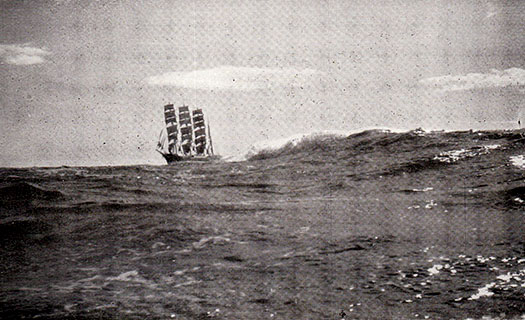
.....yet for many old salts, the true image is the lone ship at sea, going about her business. This photo of a four-masted barque was taken from a small cruising boat in the 1930s
But an ideas-laden shooting of the breeze with O'Hagan soon shows that we're going to have to learn to think a long way out of the box before we begin to meet the demanding expectations of this man and his board of trustees and directors, and the much-anticipated presence of the Tall Ships in Belfast is only a trigger to help activate a much more complex vision. Neil O'Hagan hopes not only to be instrumental in the creation of a new Irish sailing ship, but he also hopes to change the way in which we perceive such a vessel, and our expectations of the way she will be used.
In our initial blog on this back on January 17th, we thought we were making a tellingly adverse point in suggesting that the barquentine Spirit of New Zealand - which the AYT reckons will provide the best model for the development of their project – is not so much a sail training tall ship as we know it, but rather, with her large complement of 40 "trainees", she's more of a floating schoolship which happens to set sails.
Far from being blown out of the water by this "damning" criticism which I and others had voiced, O'Hagan was delighted that we'd lit upon this aspect of the plan. "Old-fashioned sail training has had its day" he says. "When education authorities and social service bodies and welfare funds and philanthropic organisations are looking for some way to provide interesting, satisfying and ultimately long-term-beneficial experiences for young people of all backgrounds and varying states of mental health including the very happily normal, they expect a much broader curriculum than is provided by the traditional sail training model".
"And come to that, so do the young people themselves. If sailing is genuinely their great leisure interest, they'll be into it already at a personal level among like-minded friends. But if they're more typical young people of today, they'll have a wide range of interests, and during the ten day cruises which we hope to make the backbone of the new ship's programme, the sailing will only be part of it."
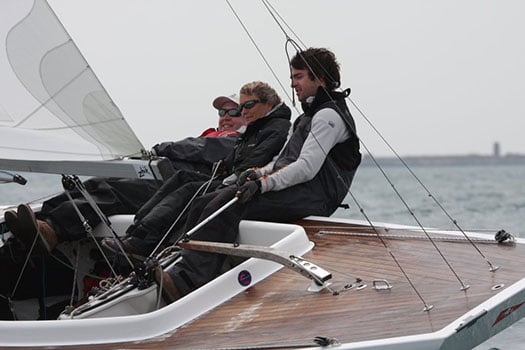
Away from the day job - Neil O'Hagan helming a Dragon
Its not that O'Hagan is anti-sailing. Far from it – he has been seen in the thick of things in the midst of the International Dragon Class in recent years. But a good liberal education with time in the Smurfit Business School in UCD and extensive family links all along Ireland's eastern seaboard north and south, plus direct business experience in both Dublin and Belfast, give him a breadth of vision to provide the AYT with a real sense of purpose.
The Atlantic Youth Trust has been quietly building itself since it emerged from a representative workshop researching the building of a sailing ship for Ireland, held in Dublin Port in the Spring of 2011. From that, a Steering Group of Lord Glentoran and Dr Gerald O'Hare from the north, and Enda O'Coineen and David Beattie from the south – all of whom had worked together before on other north-south youth sailing projects – was set up, and they commissioned a professional consultancy group – CHL Consulting of Dun Laoghaire – to work with them in producing a Vision & Business Plan, which eventually ran to 96 detailed pages.
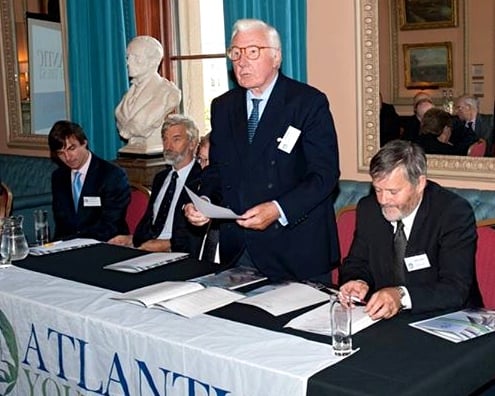
The Chairman Lord Glentoran (Gold Medallist at the 1965 Winter Olympics) at the AGM of the Atlantic Youth Trust with Executive Director Neil O'Hagan (left), Sean Lemass and Director Enda O'Coineen (right)
In due course, the Atlantic Youth Trust emerged with Olympic Gold Medal veteran Lord Glentoran as Chairman. And with Neil O'Hagan as Executive Director, the show was on the road with the detailed worldwide investigation of 25 successful educational schemes involving sailing ships - note we've dropped that "sail training" tag already. And in New Zealand they found something that was really new, something that fell in with their view that the double loss of the Asgard II and the Lord Rank provided an opportunity for a truly fresh look what a national sailing ship might be and do.
It's an extraordinary place, New Zealand - particularly from a maritime point of view. Far from seeing their isolation as a drawback, they use it as an advantage for fresh thinking. And they don't cling to time-hallowed ways brought over from "the old country". On the contrary, being in a new country is seen almost as an imperative for trying new ways and ideas, hence they're at the sharp end of top events like the America's Cup.
And as they were far from the fleets of established tall ships in Europe and America, with the Spirit of New Zealand they had to develop new ways of using a vessel which would spend much of her time cruising their own extensive and very varied coastline on her own, distant from the Tall Ship sailfests which are such a feature of the programme in the more compact and crowded parts of the world.

Spirit of New Zealand is barquentine-rigged
Thus by geographic necessity. New Zealand is ahead of the curve in developing ways of contemporary validity in the use of large sailing ships. We all hear of what a marvellous party the Tall Ships will activate in Belfast, just as they've done before in Dublin, Cork and Waterford. But hold hard just a moment. Isn't sail training aimed at young people mostly between the ages of 15 and 25? Surely their central involvement in vast open air quayside parties - with the inevitable underage alcohol intake possibilities – is totally at variance with the healthy idealism of the concept?
For sure, the organisers of modern Tall Ships Festivals go to enormous effort to ensure that they're genuinely family-friendly events. But the ancient traditions of sailors in port can be difficult to escape. So when you've a proposed programme which is essentially based on recruitment through continuing contact with secondary schools and similar age cohorts – as is the case with the Atlantic Youth Trust project – then it becomes increasingly desirable to have a ship which is large enough to be self-sufficient, with a viable way of onboard life built around large shared areas, such that the traditional waterfront-oriented harbour visits will no longer be such an important part of the cruise programme.

Splendid isolation. Spirit of New Zealand in an anchorage remote even by New Zealand standards
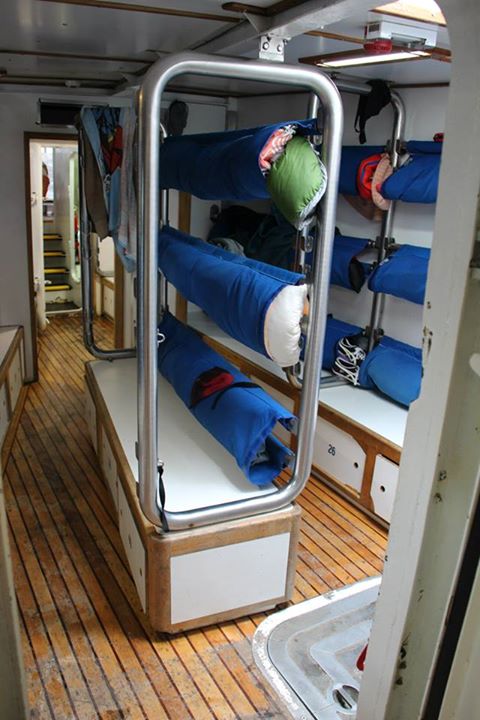
Packing them in....as she carries a crew of 40 trainees, and with space required for extensive communal areas, Spirit of New Zealand's bunks are efficiently planned
Of course the new vessel will take part in Tall Ships Races and Tall Ships Festivals, and of course she'll make the occasional ambassadorial visit, both along the Irish coast and abroad. But with the underlying philosophy of the ship being largely self-sufficient of shoreside distractions other than when they're environmentalist and educational ventures, sometimes with an expeditionary element, then the more gregarious aspects of her yearly routine will be kept well in perspective, and everyone will be the better for it.
As it's essentially a cross-border venture, equal funding from the two governments – each of which it is hoped will put up 30% of the capital expenditure - is anticipated, and with a fresh tranche of Peace Process money on the horizon, the resources are gradually building as people get used to the idea. There has also been much technical background research, and leading naval architects Dykstra of The Netherlands are on the case with an impressive scenario, for as Trustee and Director David Beattie has put it, this one isn't going to be cobbled together, it's going to be a "best in class project".
As the planned use of the vessel is essentially civilian, she will be Ireland's sailing ship without being the national sailing ship. There's more than a slight difference to the Asgard situation. In many other countries, the most impressive tall ships are part of the naval service, but in Ireland we have a Naval Service sailing vessel already, she is the ketch Creidne which was the national sail training vessel between the decommissioning of the first Asgard in 1974 and the commissioning of Asgard II in 1981. In recent years, she has had a major refit and is now actively sailed, but as Ireland's Naval Service is so essentially Cork-based, the Creidne is very much part of the scene in Cork Harbour and the Naval Base at Haulbowline.
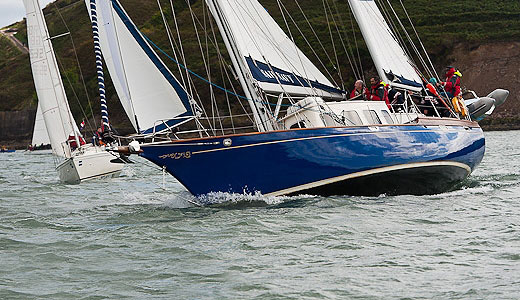
The Naval Service have Creidne for sail training purposes for their own personnel. Photo: Bob Bateman
In fact, although the Atlantic Youth Trust does have a Cork element to it, and advisers include several leading figures in the Cork marine industry, the reality is that it is first and foremost a cross-border enterprise between offices in Dublin and Belfast.
This means that Cork – which is the true capital of maritime development in Ireland, and I mean that in all seriousness – is an associate port to the Atlantic Youth Trust project, rather than a central pillar of it. But I don't think the people of Cork would wish to have it any other way. When I was in the southern capital for the fund-raiser for the new National 18 class development a month or so ago, Class President Dom Long kicked off proceedings by explaining how it was the Corkonian sense of independence which had inspired the mighty leap in National 18 design. He did this by showing a map which neatly illustrated the Cork sailor's view of Ireland.

The Cork sailor's view of Ireland
It says everything. But I don't think the Atlantic Youth Trust should lose any sleep over the fact that they might be seen as being on a Dublin-Belfast axis from which Cork is as usual going its own sweet way. 'Twas ever thus. And anyway, in the end the Corkmen will probably provide many of the officers for the proposed new vessel to which we wish, on this fine Easter Saturday morning, the very fairest of fair winds.
































































